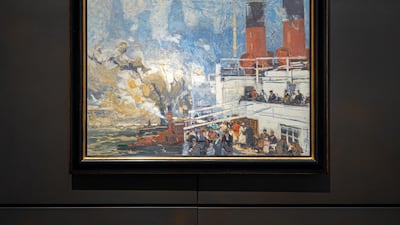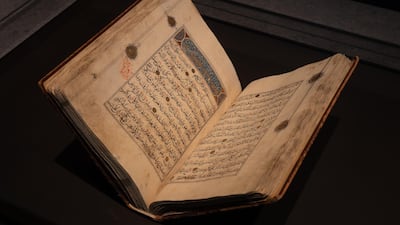A trio of worshippers gather in one display – one from Gabon, another from present-day Iraq and the third from Egypt – followed by a series of paintings from Monet, Van Gogh and Renoir. These artefacts and artworks have been brought together by Louvre Abu Dhabi as the museum welcomes new additions to its acquisitions and loans for the season.
Here, we look at five new displays to see at Louvre Abu Dhabi as the new season at the museum begins.
Statues of worship
Housed in the Grand Vestibule are the first few objects visitors see. The Sumerian Statue of a Female Worshipper is a stone statue created in the third millennium BCE. Likely to have been displayed in a temple, the statue would have been placed next to a divinity figure.
As Souraya Noujaim, Louvre Abu Dhabi’s scientific, curatorial and collections management director, explains, the object belongs to a group of Sumerian statues produced in modern-day Southern Iraq and Syria.

“They are usually dressed in sheepskin and are figures of men praying, standing with the gesture of intercession between the divine and the Earth,” she says. “The fact that it is a female is extremely rare. She has a soft smile on her face and her hands clasp in front of her. Her eyes were probably engraved in black and white stones. She is a testimony of the place of women in worship at the time.”
Another artefact is the Kneeling Figure in black stone from Egypt, believed to be from 400 to 300 BC. His position indicates he may have been praying to Amun, the ancient Egyptian god of the sun and air.
Both figurines have recently been acquired from private dealers and are now part of Louvre Abu Dhabi’s permanent collection.
Osman Hamdi Bey’s Orientalist work
On loan from Musee d'Orsay in Paris is a 1903 work by painter and archaeologist Osman Hamdi Bey, which depicts a dervish inside an opulent mausoleum. Here, the artist casts light into the interiors of the room from an arched entryway. The Orientalist work, replete with the stereotypical dark atmosphere and settings, as well as the characters, is contrasted with an earlier work by the painter and archaeologist, Young Emir Studying, part of Louvre Abu Dhabi's permanent collection.
“In both paintings you have the references to the traditional Islamic art, but one is very Orientalist and the other is more subtle, calm, inspired by the art of miniature and also photography,” Noujaim explains.
The first of Monet’s Haystacks series
It would be easy to say that the subject of Monet's remarkable Haystacks are just heaps of grain. In a series of 25 paintings, he repeatedly renders haystacks in the French countryside as they appeared throughout the year. But what the artist truly wanted to capture was light – how it changed throughout the day and the seasons.
One of the first of Monet's notable Haystacks is on view as part of the museum's modernist section. The display at Louvre Abu Dhabi gathers the works of Van Gogh, Renoir and Degas, intended by Noujaim to demonstrate a wider view of trends within Western art and societies.
“With the Industrial Revolution, the status of the image and topics chosen by the artists were changing considerably,” she says.
In the case of Monet, for example, “he moved out of his studio and painted in real landscapes”.
Placing loans and items from the museum’s permanent collection side to by side, Noujaim plots the progression of these changes chronologically.
Also on loan from Musee d'Orsay is Monet's Haystacks, End of Summer, from 1891. It prefigures the French artist's famous series of Rouen Cathedral and Charing Cross Bridge in London, and further cements his Impressionist style.
“He used light and repetition to take his technique to a more abstract approach,” says Noujaim.
Van Gogh’s developing style
The Modernist section also includes Van Gogh's Encampment of Gypsies with Caravans (1888), which exemplifies this "entry into the modern world", as Noujaim puts it, with its renewed focus on real-life subjects common in Post-Impressionism.
“These artists were drawing attention to subjects that were not previously considered important. Their techniques have evolved from a conventional representation to a more free touch towards abstraction,” she explains.

In this work, one can see the beginnings of what would become Van Gogh’s memorable style – his use of strong brushstrokes, his vibrant palette and focus on light.
For each of these displays, Noujaim has considered the connections and contexts in the artworks in order to tell their stories along Louvre Abu Dhabi’s ethos. By bringing together two disparate works, such as the Sumerian statue and Kneeling Figure, for example, the curator bonds the objects through their ideas rather than their timelines or geographies. “Our narrative is a universal narrative. We try to find the visual, artistic and historical connections between artworks,” she says.
More information is available at louvreabudhabi.ae








